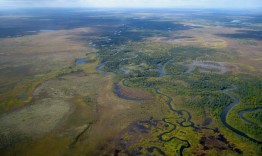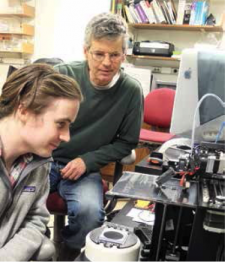Scientists from Aquatic and Fishery Sciences and other institutions are learning a lot about where Chinook salmon swim in Alaska’s Bristol Bay region through chemical signatures recorded in their ear bones. Similar to a tree’s growth rings, this bone—called an otolith—accumulates layers as the fish grows. Acting as a little recorder, each layer of the otolith corresponds to the unique chemical signatures of the waters in which they swam.
Read more at UW Today »2014-2015 award recipients honored at the College’s Spring Celebration
The festive vibe at the College of the Environment’s 1st Annual Spring Celebration provided a perfect backdrop in which to bid adieu to the academic school year and congratulate the College’s 2014-2015 award winners. Focused on College faculty, students, and staff, the event was an opportunity for friends and colleagues across all departments to gather and celebrate. As attendees mingled, members of the College’s Executive Committee served up ice cream sundaes.
Read more »New knowledge and technology help scientists track harmful algae
Though the waters of Puget Sound are full of beneficial algae, which provide oxygen, food, and shelter for other creatures, it’s the nasty ones that usually make the news, when they "bloom" into toxic pools, harming fish and humans. Now, researchers working with Washington Sea Grant have started to narrow in on harmful algae’s behaviors, and are developing some slick techniques that they hope will lead to much more effective detection and monitoring.
Read more »Martian core formation, striped marlin and more: Weekly published research, May 11
Each week we share the latest peer-reviewed publications coming from the College of the Environment. Over the past week, six new articles co-authored by members of the College of the Environment were added to the Web of Science database, including studies on hydrothermal vents, billfish, and China's air quality. Read on!
Read more »Fishermen, communities need more than healthy fish stocks
Aquatic and Fishery Sciences’ Chris Anderson and a team of scientists have developed a new assessment that looks at fisheries’ economic and community benefits, as well as ecological health. Anderson and his team created new ways of measuring three performance indicators – ecology, economics, and community – all of which can be applied across species, management approaches, and nations. To characterize a fishery, the authors drew on local experts’ knowledge, scoring each response and averaging them in each category.
Read more at UW Today »





